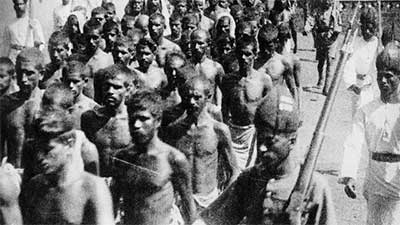Mopilla (Malabar) Rebellion of 1921
CONTEXT:
Inaugurating the ‘Mappila Riots Martyrs Remembrance Year’ in Kerala, National executive member of Rashtriya Swayamsewak Sangh (RSS), Ram Madhav accuses the Left Democratic Front government of whitewashing the Mappila riots as a Communist movement against the bourgeois and zamindars. He called this movement as "first manifestation of the Taliban mindset".
FOR PRELIMS:
- The year 2021 will mark the 100th year anniversary of the Malabar rebellion of 1921
ORIGIN OF THE REBELLION:
- Also known as The Moplah Rebellion, or Moplah Riots of 1921 was the culmination of a series of riots by Mappila Muslims of Kerala in the 19th and early 20th centuries against the British and the Hindu landlords in Malabar (Northern Kerala). It was an armed revolt. It was led by Variyamkunnath Kunjahammed Haji.
- Muslims had arrived in Kerala in the 7th century AD as traders via the Arabian Sea even before north India was invaded by Muslim armies from the west. They were given permission to carry on trade and settle by the native rulers. Many of them married local women and their descendants came to be called Moplahs (which means son-in-law in Malayalam).
- During Hyder Ali’s invasion of Malabar in the 18th century, many Hindu landlords fled Malabar to neighbouring areas and the Moplah tenants were accorded ownership rights to the lands.
- After the death of Tipu Sultan in 1799 in the Fourth Anglo-Mysore War, Malabar came under British authority as part of the Madras Presidency. Then, the British set out to restore ownership rights to the Jenmis who had earlier fled the region.
- This caused a series of riots by the Moplahs starting from 1836. Between 1836 and 1896, they killed many government officers and Hindu landlords.
COURSE OF THE REBELLION:
- The Khilafat Movement had started in 1919 in India incited communal feelings among the Moplahs and caused large-scale violence that saw systematic persecution of Hindus and British officials. Many homes and temples were destroyed.
- From August 1921 till about the end of the year, the rebels had under their control large parts of Malabar.
- By the end of the year, the rebellion was crushed by the British who had raised a special battalion, the Malabar Special Force for the riot.
- In November 1921, 67 Moplah prisoners were killed when they were being transported in a closed freight wagon from Tirur to the Central Prison in Podanur. They died of suffocation. This event is called the Wagon Tragedy.
CONSEQUENCES OF REBELLION:
- The Moplah uprising is a widely debated one with some people arguing that it was a nationalist uprising against the British while others say that it was a communally charged series of riots.
- Sir C Shankaran Nair, a former President of the INC, criticised Gandhi’s support of the Khilafat Movement as one of the causes of the violence seen during the uprising.
RECENT ISSUE REGARDING THE REBELLION
- A report by the ICHR-constituted committee (Indian Council of Historical Research) in 2016 has sought the removal of names of 387 ‘Moplah rioters’ (Including leaders Ali Musliyar and Variamkunnath Ahmad Haji) from the list of martyrs.
- In the ‘Dictionary of Martyrs’, published by the Union Ministry of Culture in collaboration with the Indian Council of Historical Research, Variankunnath Kunhamad Haji and Ali Musliyar, the chief architects of the Moplah Massacre, were deemed to be martyrs. The book was published in 2019.
- This is because the report describes Haji as the “notorious Moplah Riot leader” and a “hardcore criminal,” who “killed innumerable innocent Hindu men, women, and children during the 1921 Moplah Riot, and deposited their bodies in a well, locally known as Thoovoor Kinar”.
- It also noted that almost all the Moplah outrages were communal. They were against Hindu society and done out of sheer intolerance.
Sources
- The Hindu
- The Indian Express
- PIB







